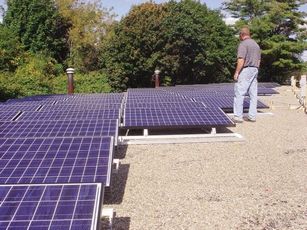G&E installs solar panels as 'green' effort and educational demonstration
By JOHN TESSIER, Special Writer
November 12, 2009
MIDDLEBORO — The Middleboro Gas and Electric Department has taken a small step forward in the "green" approach to producing electricity. On Oct. 6, 80 solar panels were installed on the roof of the MG&E's substation on Wareham Street. According to the MG&E's Public Communications Manager Sandy Richter, other towns in Massachusetts have also started similar projects, but none have done it with as many solar panels as Middleboro has. She went on to state the Braintree has also started this project, but has only installed 48 panels.

PHOTO COURTESY OF MG&E
SOLAR ARRAY: 80 solar panels have been installed on the roof of the Gas and Electric Department’s substation on Wareham Street to produce electricity at the station, but also as an educational display.
"The 16.8 kilowatt array, one of the largest physical installations thus far by a Massachusetts municipal utility, will produce up to 2,200 kilowatts hours of electricity in a typical sunny summer month," states the MG&E's press release on this project.
Visitors to the MG&E's administrative office on Main Street can see a web-based display on a large LCD monitor in the main lobby. The display shows actual data coming from the solar panel array. Charts display how much energy is being produced, which updates every 15 minutes. The display also estimates the carbon offset by producing this energy without the burning of any fossil fuels.
For those interested in the project but don't want to keep popping into the office, the same information can be seen on www.solrenview.com. Just click on the Live Sites tab, and then scroll down to Great Northern Electric, LLC under the installers header. Right next to the Great Northern Electric is a link for the "Middleborough Photovoltaic Project." Click on the link to open the data page for the solar panel array.
According to the press release the amount of energy that is produced could power four to five homes. Ms. Richter explained that the 16.8 kilowatts are available when the panels are set at the optimal angle and have absolutely no obstructions between the panels and the sun. This may sound like an easy task. According to Ms. Richter the best place for them to be put up was on the substation but that is not without some obstruction from trees, and the angle they are forced to keep the panels at does not constitute the best angle to get the most out of them. This type of energy production is best used in areas that are sunny most of the time and have wide-open unobstructed views of the sky, such as Arizona.
"We wanted to set up a demonstration project because honestly, the 80 panels that we have covering the roof at the electric station doesn't power half the office over there," Ms. Richter said.
She went on to say that for a homeowner in this area who may be interested in putting up solar panels on their roof, it would most likely not provide the amount of electricity that most homes need. Ms Richter was quick to add that the reason for the project is more to do with showing the community how solar panels work and their potential for creating electricity without producing any emissions. She also stated that she has had a lot of townspeople ask her about solar panels and whether or not they would a viable investment for a homeowner.
Ms. Richter stated that she cringes when she encounters someone who wants to install solar panels on their home as there are much more cost effective ways of reducing your electrical bill. She said replacing windows and "tightening up" a home using current building methods is a cheaper method of reducing electrical usage.
Part of the reason for the poor production of electricity is that the energy produced by the panels depends on the weather. A cloudy day will not produce enough electricity for a single home whereas a sunny day could provide enough electricity to power four to five homes. The problem lies with the inability to store the energy produced from the solar panels. Without this storage capability, the energy is used as it is generated and would be rendered almost useless during real cloudy stretches. Ms. Richter mentioned November as a month that would be affected by this issue, stating that November is typically our cloudiest month.
The solar panels cost $130,000 and were "a bargain," Ms. Richter said. The cost for the project was paid for by the MG&E but the IRS approved the municipality for a Clean Renewable Energy Bond and therefore this is of no cost to the town's taxpayers. The bond allows the town municipality to spread the cost of the panels out over the span of 10 years at zero percent interest.
